Cut/copy/paste data
-
basic editing operations
-
Spell checking
-
Manage files
-
Open or create new files and folders
-
Share files and folders
-
Navigate through your document
-
Select, cut, copy, paste text
-
Undo/redo your actions
-
Navigate through your spreadsheet
-
Select, cut, copy, paste, AutoFill data
-
Undo/redo your actions
-
Navigate through your presentation
-
Select, cut, copy, paste text and objects
-
Undo/redo your actions
-
Manage files
-
Open or create new files and folders
-
Share files and folders
-
Navigate through your document
-
Select, cut, copy, paste text
-
Undo/redo your actions
-
Switch between editing modes
-
Navigate through your spreadsheet
-
Select, cut, copy, paste data
-
Undo/redo your actions
-
Navigate through your presentation
-
Select, cut, copy, paste text and objects
-
Undo/redo your actions
-
Manage files
-
Open or create new files and folders
-
Share files and folders
-
Navigate through your document
-
Select, cut, copy, paste text
-
Undo/redo your actions
-
Navigate through your spreadsheet
-
Select, cut, copy, paste data
-
Undo/redo your actions
-
Freeze panes
-
Navigate through your presentation
-
Select, cut, copy, paste text and objects
-
Undo/redo your actions
-
Navigate through your presentation
-
Select, cut, copy, paste text and objects
-
Undo/redo your actions
-
Manage files
-
Open or create new files and folders
-
Share files and folders
-
Navigate through your document
-
Select, cut, copy, paste text
-
Undo/redo your actions
-
Navigate through your spreadsheet
-
Select, cut, copy, paste data
-
Undo/redo your actions
-
Freeze panes
-
Navigate through your presentation
-
Select, cut, copy, paste text and objects
-
Undo/redo your actions
-
copy and paste data
-
Copy/paste data, undo/redo your actions
-
Copy/paste text passages, undo/redo your actions
-
Cut/copy/paste data
-
Select, cut, copy, paste text
-
Select, cut, copy, paste, AutoFill data
-
Select, cut, copy, paste text and objects
-
Select, cut, copy, paste text
-
Select, cut, copy, paste data
-
Select, cut, copy, paste text and objects
-
Select, cut, copy, paste text
-
Select, cut, copy, paste data
-
Select, cut, copy, paste text and objects
-
Select, cut, copy, paste text
-
Select, cut, copy, paste data
-
Select, cut, copy, paste text and objects
Use basic clipboard operations
To cut, copy and paste data in the current spreadsheet make use of the right-click menu or use the corresponding icons of the Spreadsheet Editor available on any tab of the top toolbar,
- Cut - select data and use the Cut option from the right-click menu, or the Cut icon on the top toolbar to delete the selected data and send them to the computer clipboard memory. The cut data can be later inserted to another place in the same spreadsheet.
- Copy - select data and either use the Copy icon at the top toolbar or right-click and select the Copy option from the menu to send the selected data to the computer clipboard memory. The copied data can be later inserted to another place in the same spreadsheet.
- Paste - select a place and either use the Paste icon on the top toolbar or right-click and select the Paste option to insert the previously copied/cut data from the computer clipboard memory to the current cursor position. The data can be previously copied from the same spreadsheet.
In the online version, the following key combinations are only used to copy or paste data from/into another spreadsheet or some other program, in the desktop version, both the corresponding buttons/menu options and key combinations can be used for any copy/paste operations:
- Ctrl+X key combination for cutting (Cmd+X for macOS);
- Ctrl+C key combination for copying (Cmd+C for macOS);
- Ctrl+V key combination for pasting (Cmd+V for macOS).
Note: instead of cutting and pasting data within the same worksheet you can select the required cell/cell range, hover the mouse cursor over the selection border so that it turns into the Arrow icon and drag and drop the selection to the necessary position.
To enable / disable the automatic appearance of the Paste Special button after pasting, go to the File tab > Advanced Settings and check / uncheck the Show the Paste Options button when the content is pasted checkbox.
Use the Paste Special feature
Note: For collaborative editing, the Paste Special feature is available in the Strict co-editing mode only.
Once the copied data is pasted, the Paste Special button appears next to the lower right corner of the inserted cell/cell range. Click this button to select the necessary paste option or use the Ctrl key to open the Paste Special menu, then press the letter key given in the brackets next to the required option.
When pasting a cell/cell range with formatted data, the following options are available:
- Paste (Ctrl then P) - allows you to paste all the cell contents including data formatting. This option is selected by default.
-
The following options can be used if the copied data contains formulas:
- Paste only formula (Ctrl then F) - allows you to paste formulas without pasting the data formatting.
- Formula + number format (Ctrl then O) - allows you to paste formulas with the formatting applied to numbers.
- Formula + all formatting (Ctrl then K) - allows you to paste formulas with all the data formatting.
- Formula without borders (Ctrl then B) - allows you to paste formulas with all the data formatting except the cell borders.
- Formula + column width (Ctrl then W) - allows you to paste formulas with all the data formatting and set the source column`s width for the cell range.
- Transpose (Ctrl then T) - allows you to paste data switching them from columns to rows, or vice versa. This option is available for regular data ranges, but not for formatted tables.
-
The following options allow you to paste the result that the copied formula returns without pasting the formula itself:
- Paste only value (Ctrl then +V) - allows you to paste the formula results without pasting the data formatting.
- Value + number format (Ctrl then A) - allows to paste the formula results with the formatting applied to numbers.
- Value + all formatting (Ctrl then E) - allows you to paste the formula results with all the data formatting.
- Paste only formatting (Ctrl then R) - allows you to paste the cell formatting only without pasting the cell contents.
-
Paste link (Ctrl then N) - allows you to paste the external link to a cell or range of cells in another spreadsheet within the current portal (in the online editor) or in a local file (in the desktop editor).

-
Paste
- Formulas - allows you to paste formulas without pasting the data formatting.
- Values - allows you to paste the formula results without pasting the data formatting.
- Formats - allows you to apply the formatting of the copied area.
- Comments - allows you to add comments of the copied area.
- Column widths - allows you to set certal column widths of the copied area.
- All except borders - allows you to paste formulas, formula results with all its formatting except borders.
- Formulas & formatting - allows you to paste formulas and apply formatting on them from the copied area.
- Formulas & column widths - allows you to paste formulas and set certaln column widths of the copied area.
- Formulas & number formulas - allows you to paste formulas and number formulas.
- Values & number formats - allows you to paste formula results and apply the numbers formatting of the copied area.
- Values & formatting - allows you to paste formula results and apply the formatting of the copied area.
-
Operation
- Add - allows you to automatically add numeric values in each inserted cell.
- Subtract - allows you to automatically subtract numeric values in each inserted cell.
- Multiply - allows you to automatically multiply numeric values in each inserted cell.
- Divide - allows you to automatically divide numeric values in each inserted cell.
- Transpose - allows you to paste data switching them from columns to rows, or vice versa.
- Skip blanks - allows you to skip pasting empty cells and their formatting.

When pasting the contents of a single cell or some text within autoshapes, the following options are available:
- Source formatting (Ctrl+K) - allows you to keep the source formatting of the copied data.
- Destination formatting (Ctrl+M) - allows you to apply the formatting that is already used for the cell/autoshape where the data are to be inserted to.
Paste delimited text
When pasting the delimited text copied from a .txt file, the following options are available:
The delimited text can contain several records, and each record corresponds to a single table row. Each record can contain several text values separated with a delimiter (such as a comma, semicolon, colon, tab, space or other characters). The file should be saved as a plain text .txt file.
- Keep text only (Ctrl+T) - allows you to paste text values into a single column where each cell contents corresponds to a row in the source text file.
-
Use text import wizard - allows you to open the Text Import Wizard which helps to easily split the text values into multiple columns where each text value separated by a delimiter will be placed into a separate cell.
When the Text Import Wizard window opens, select the text delimiter used in the delimited data from the Delimiter drop-down list. The data split into columns will be displayed in the Preview field below. If you are satisfied with the result, click the OK button.
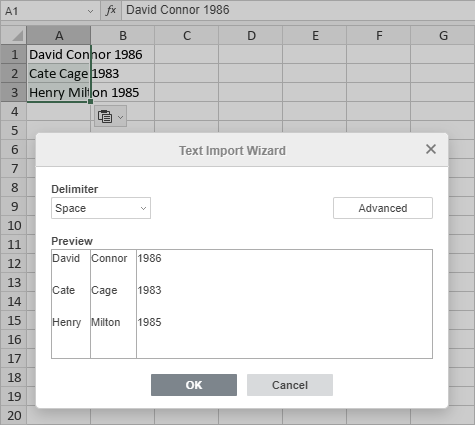
If you pasted delimited data from a source that is not a plain text file (e.g. text copied from a web page etc.), or if you applied the Keep text only feature and now want to split the data from a single column into several columns, you can use the Text to Columns option.
To split data into multiple columns:
- Select the necessary cell or column that contains data with delimiters.
- Switch to the Data tab.
- Click the Text to columns button on the top toolbar. The Text to Columns Wizard opens.
- In the Delimiter drop-down list, select the delimiter used in the delimited data.
-
Click the Advanced button to open the Advanced Settings window in which you can specify the Decimal and Thousands separators.

- Preview the result in the field below and click OK.
After that, each text value separated by the delimiter will be located in a separate cell.
If there is some data in the cells to the right of the column you want to split, the data will be overwritten.
Use the Auto Fill option
To quickly fill multiple cells with the same data use the Auto Fill option:
- select a cell/cell range containing the required data,
-
move the mouse cursor over the fill handle in the right lower corner of the cell. The cursor will turn into the black cross:
- drag the handle over the adjacent cells to fill them with the selected data.
Note: if you need to create a series of numbers (such as 1, 2, 3, 4...; 2, 4, 6, 8... etc.) or dates, you can enter at least two starting values and quickly extend the series selecting these cells and dragging the fill handle. For a series of days of the week or months, enter the initial value and drag the fill handle.
To further customize the cell autofilling, drag the range with the right mouse button to open the Auto Fill context menu:
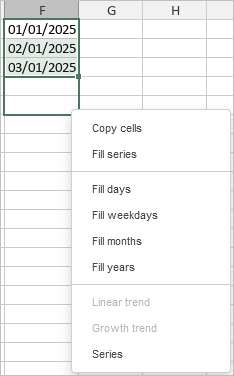
- Copy cells - the cell range content will be copied into your clipboard.
- Fill series - autofill based on the established pattern in the selected cell range.
- Fill days - only days will follow the established pattern, e.g., 01/01/2025, 02/01/2025 ... (DD-MM-YYYY).
- Fill weekdays - only weekdays will follow the established pattern, the weekends will be omitted.
- Fill months - only months will follow the established pattern, e.g., 01/01/2025, 01/02/2025 ... (DD-MM-YYYY).
- Fill years - only years will follow the established pattern, e.g., 01/01/2025, 01/01/2026 ... (DD-MM-YYYY).
- Linear trend - the autofill will follow the linear trend (1, 2, 3 ...).
- Growth trend - the autofill will follow the exponential growth trend (1, 2, 4, 8, 16 ...).
- Series - opens the Series menu, where you can further customize the settings.
Fill cells in the column with text values
If a column in your spreadsheet contains some text values, you can easily replace any value within this column or fill the next blank cell selecting one of already existing text values.
Right-click the necessary cell and choose the Select from drop-down list option in the contextual menu.
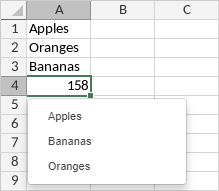
Select one of the available text values to replace the current one or fill an empty cell.
Fill cells using the Series tool
-
Select a cell/cell range containing the initial data and some empty cells in the necessary direction. Click the Fill icon on the Home tab of the top toolbar and choose the Series option.
You can also use the Down, Right, Up, Left options to fill the selected empty cells.
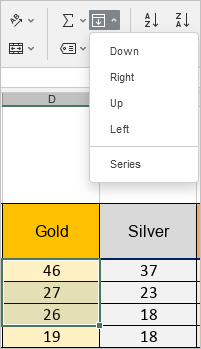
There is another way to access the Series window. You can select the initial data, move the mouse cursor over the fill handle in the right lower corner of the cell, click and hold the right mouse button on the fill handle, then drag down, up, right, or left and release the right mouse button - the context menu appears with the Series option.
-
In the Series dialog window, select the necessary options and click OK:
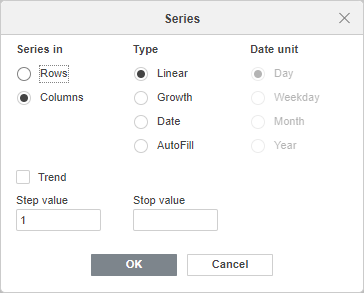
- Series in: Rows, Columns - select the direction to fill cells.
- Type: Linear is used to add the step value to the starting value and then to each subsequent value, Growth is used to multiply the starting value by the step value, Date is used to fill cells with a series of dates, AutoFill is used to fill cells with data based on other cells.
- Date unit: Day, Weekday, Month, Year - select the date unit you want to increase the series by.
- Trend - check this box if there is more than one starting value in the series.
- Step value - select the numerical value you want to increase the series by. By default, it is set to 1.
- Stop value - specify the last value in the series.
Return to previous page